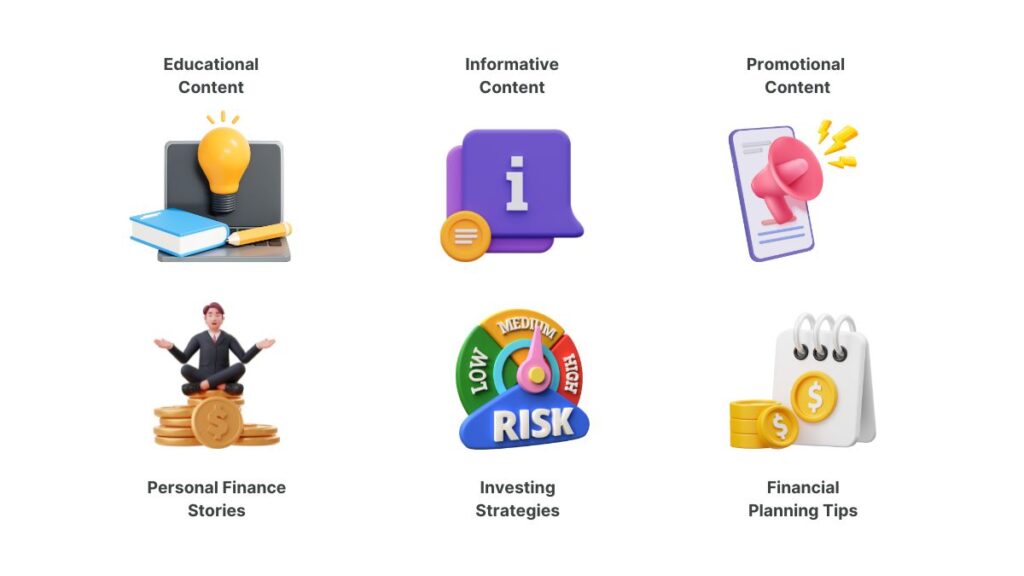Welcome to the world of creating content for finance businesses and creators!
It’s an exciting and rewarding endeavor that allows you to share your financial expertise, educate your audience, and make a positive impact.
Whether you’re a finance professional, a blogger, or a social media enthusiast, this blog will provide you with valuable insights and tips to create compelling content that engages your audience and establishes your authority in the finance industry.
Get ready to unleash your creativity and embark on this exciting journey of creating informative and engaging finance content!
Understanding your target audience

To create effective content for finance businesses and creators, it is crucial to have a deep understanding of your target audience. Knowing who you are creating content for allows you to tailor your messaging, style, and approach to resonate with them on a deeper level. Here are some key aspects to consider when understanding your target audience:
Demographics
Start by identifying the demographic characteristics of your audience. Consider factors such as age, gender, location, education level, income bracket, and occupation. This information provides a foundational understanding of the people you are targeting and helps you shape your content to suit their specific needs and interests.
Psychographics
Dive deeper into the psychographic aspects of your audience. Understand their values, beliefs, attitudes, interests, and motivations. Are they financially conservative or risk-takers? Are they seeking financial independence or looking for guidance on managing their finances? Knowing their psychographic profile helps you craft content that resonates with their desires and aspirations.
Knowledge and Experience
Assess the level of knowledge and experience your audience has in the finance domain. Are they beginners looking for basic financial literacy information, or are they experienced investors seeking advanced strategies? Tailor your content to match their level of understanding, ensuring it is neither too simplistic nor too complex.
Pain Points and Challenges
Identify the common pain points and challenges your target audience faces regarding finance. Are they struggling with debt management, budgeting, or retirement planning? Addressing their specific challenges demonstrates that you understand their struggles and positions you as a valuable resource that can offer solutions.
Communication Preferences
Determine how your audience prefers to consume content. Do they enjoy reading long-form articles, watching informative videos, or listening to podcasts? Understanding their preferred communication channels helps you deliver content in a format that best engages and resonates with them.
Feedback and Engagement
Actively seek feedback from your audience and encourage engagement. Pay attention to comments, questions, and suggestions to gain insights into their preferences, concerns, and interests. Engaging in dialogue and incorporating their feedback into your content helps strengthen your connection with them and ensures your content remains relevant and valuable.
By gaining a comprehensive understanding of your target audience, you can create content that addresses their specific needs, speaks their language, and provides them with valuable insights and solutions. Remember, effective content is all about connecting with your audience on a personal level and delivering information that is tailored to their unique circumstances.
Types of content for finance businesses

When it comes to creating content for finance businesses, there are various types that can effectively engage your audience and serve different purposes. Here are three key types of content to consider:
Educational Content
Educational content aims to provide valuable information, insights, and guidance to your audience. This type of content helps educate your audience on various financial topics, empowering them to make informed decisions. Examples of educational content include:
- In-depth articles or blog posts explaining complex financial concepts in a simplified manner.
- Step-by-step guides or tutorials on budgeting, investing, or tax planning.
- Infographics or visual content that visually represents financial information or processes.
- Webinars or online courses that offer comprehensive learning experiences on specific financial topics.
Informative Content
Informative content focuses on providing updates, news, and analysis related to the finance industry. This type of content helps your audience stay informed about the latest trends, developments, and regulations. Examples of informative content include:
- News articles or blog posts covering recent financial market trends or events.
- Research reports or whitepapers that analyze specific financial sectors or investment opportunities.
- Podcast episodes featuring interviews with industry experts or discussions on current financial topics.
Social media updates or newsletters sharing industry insights or quick tips.
Promotional Content
Promotional content is designed to promote your products, services, or brand. While it should be used sparingly, it plays an important role in driving conversions and business growth. Examples of promotional content include:
- Case studies or success stories highlighting how your financial services or products have benefited clients.
- Product demonstrations or explainer videos showcasing the features and benefits of your offerings.
- Client testimonials or reviews that build credibility and trust.
- Limited-time offers, discounts, or promotions to incentivize potential customers to take action.
Personal Finance Stories
Step into the world of personal finance narratives, where real-life stories take center stage. Share your own financial journey, complete with its triumphs, setbacks, and valuable lessons. By opening up about your experiences, you inspire others to navigate their own financial challenges with courage and determination. Unveil the moments of financial transformation, from conquering debt to achieving ambitious goals, and let your audience see that they too can rewrite their financial narrative.
Investing Strategies
Empower your audience with the knowledge and insights they need to navigate the world of investing. Dive into different investment strategies, dissect the intricacies of portfolio management, and demystify the ever-evolving market trends. From discussing long-term investment approaches to exploring emerging opportunities, guide your followers through the fascinating world of investing. Equip them with the tools and information they need to make informed decisions and take charge of their financial future.
Financial Planning Tips
Help your audience unleash their financial potential through practical and actionable tips for effective financial planning. From budgeting hacks to debt management strategies, offer guidance on how to create a solid financial foundation. Educate your followers on the importance of setting financial goals, building emergency funds, and planning for retirement. By sharing insights on effective money management, you empower individuals to take control of their finances and achieve greater financial well-being.
It’s important to strike a balance between these three types of content to provide a well-rounded experience for your audience. Educational and informative content establishes your expertise and builds trust, while promotional content helps drive business objectives. By understanding the needs and preferences of your audience, you can create a content mix that educates, informs, and promotes in a way that resonates with them and ultimately drives engagement and conversions.
Content for finance businesses: Ideas

When it comes to creating content for finance businesses, there are numerous content ideas that can help you engage your audience and provide value. Here are three content ideas to consider:
Budgeting Tips:
- Create blog posts or articles that offer practical budgeting tips for individuals or businesses.
- Develop downloadable budget templates or spreadsheets to help your audience get started with budgeting.
- Share video tutorials demonstrating effective budgeting techniques and tools.
- Offer case studies showcasing how budgeting strategies have helped people achieve their financial goals.
- Conduct Q&A sessions or live streams where you answer budgeting-related questions from your audience.
Investment Strategies:
- Write comprehensive guides on different investment strategies, such as long-term investing, dividend investing, or value investing.
- Create video content that explains the basics of investing and how to develop an investment portfolio.
- Share success stories or interviews with experienced investors to inspire and educate your audience.
- Offer analysis and commentary on market trends, highlighting potential investment opportunities.
- Host webinars or workshops on investment topics, providing actionable insights and strategies.
Market Insights:
- Publish regular market update articles or videos that summarize the latest financial market trends and developments.
- Offer expert analysis on specific sectors or industries, helping your audience make informed investment decisions.
- Share infographics or visual content that visually represents market data or economic indicators.
- Provide in-depth research reports or whitepapers on emerging markets or investment themes.
- Conduct interviews with industry experts or invite guest contributors to share their market insights.
Content ideas for finance business creators
Finance doesn’t have to be dry and boring. Infuse your content with a fun and encouraging tone that makes your audience excited to learn more about money matters.
Whether you’re reviewing books, recommending podcasts, or analyzing finance news, bring your unique personality and storytelling flair to make finance content accessible, relatable, and enjoyable for all. Let’s break the stereotype and show the world that finance can be as thrilling as any other topic out there.
- Book Reviews
Dive into the fascinating world of finance literature and share your thoughts on the latest and greatest finance books. Whether it’s a classic personal finance guide or a cutting-edge investment manifesto, give your unique take on the concepts, ideas, and actionable strategies found within. Spark conversations and ignite curiosity among your audience by recommending must-read books that will empower them on their financial journey.
- Podcast Recommendations:
Plug into the world of finance podcasts, where insightful discussions and captivating storytelling take center stage. Share your favorite finance podcasts and the specific episodes that had you hooked. Whether it’s an interview with a financial guru, a deep dive into economic trends, or a thought-provoking exploration of behavioral finance, highlight the podcasts that provide valuable insights and entertainment in equal measure.
- Finance-Related News Analysis
Stay on top of the latest financial news and turn it into captivating content that educates and entertains. Break down complex market trends, dissect economic developments, and provide your audience with a unique perspective on how current events impact their wallets. Add a dash of humor and your personal touch to make finance news analysis a delightful and enlightening experience for your followers.
Content For Finance Businesses: Tips for creating engaging content

When it comes to creating engaging content, there are several tips and strategies you can use to captivate your audience and keep them coming back for more. Here are some key tips to consider:
- Know Your Audience: Understand who your target audience is and what they are interested in. Tailor your content to their needs, preferences, and pain points. This ensures that your content resonates with them and provides value.
- Compelling Headlines: Craft attention-grabbing headlines that spark curiosity and entice readers to click and explore your content further. A strong headline sets the tone for your content and makes a great first impression.
- Tell Stories: Incorporate storytelling elements into your content to make it relatable and engaging. Stories capture attention, evoke emotions, and connect with your audience on a deeper level.
- Use Visuals: Visual elements such as images, videos, infographics, and charts can enhance the appeal of your content. They break up the text, make it more visually appealing, and help convey complex information in a digestible way.
- Provide Value: Ensure that your content provides value to your audience. Offer insights, tips, practical advice, or solutions to their problems. When your content helps them in some way, they are more likely to engage with it and share it with others.
- Encourage Interaction: Create opportunities for your audience to engage with your content. Pose questions, ask for opinions, and encourage comments and discussions. This fosters a sense of community and keeps your audience actively involved.
Try Creating On Exly
- Use a Conversational Tone: Write in a conversational and relatable tone. Avoid jargon and complex language that may alienate your audience. Make your content easy to understand and enjoyable to read.
- Mix Up Formats: Experiment with different content formats to keep things fresh and interesting. Use a mix of articles, videos, podcasts, infographics, and interactive content to cater to different learning preferences.
- Consistency is Key: Publish content regularly and consistently. This helps you build momentum and keep your audience engaged. Set a schedule and stick to it.
- Listen to Feedback: Pay attention to feedback from your audience. Engage with their comments, respond to their questions, and take their suggestions into consideration. This shows that you value their input and helps you improve your content over time.
Wrapping Up
Congratulations, You’ve made it to the end of this wild and wonderful journey of creating engaging content. Now it’s time to let your creativity soar, sprinkle some magic into your content, and watch your audience fall head over heels for what you have to offer.
Remember, as you embark on this adventure, keep your audience at the forefront of your mind. Know them, connect with them, and cater to their needs. Your engaging content is like a special secret handshake that invites them into your world of knowledge, inspiration, and entertainment.
But above all, provide value and be their guiding light. Share insights, tips, and practical advice that make a real difference in their lives. When you become their go-to source for answers, you become a trusted friend, guiding them through the twists and turns of their journey.
Keep the conversation flowing, building a vibrant community that celebrates shared experiences. Embrace feedback, nurture relationships, and let your audience become an integral part of your content creation process. Together, you’ll create something truly magical.
And remember, be yourself, for there is no one quite like you. Inject your unique personality into every word, infusing your content with that special something that only you can bring. Your authentic voice is what sets you apart and makes your content truly shine!





